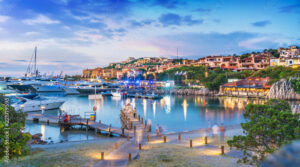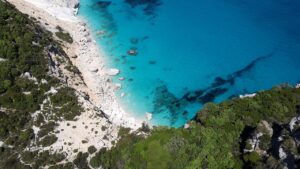Guide to Capoterra, Sardinia
Nestled on the southwestern coast of Sardinia, Italy, the picturesque town of Capoterra has witnessed a remarkable transformation over the years. With its rich history, stunning landscapes, and vibrant culture, Capoterra has become a thriving community and a popular destination for tourists seeking an authentic Sardinian experience. In this article, we will take you on a journey through time, exploring the fascinating historical background of Capoterra and uncovering the captivating stories that have shaped this enchanting town.
Ancient Origins: Traces of the Past
Capoterra’s roots can be traced back to ancient times, with evidence of human settlements dating back to the Neolithic period. The area was inhabited by various cultures, including the Ozieri Culture, as evidenced by the remains of huts found at Cuccuru de Ibba and Pranedda de Punta Sa Loriga. The presence of nuraghe, ancient stone structures, at Carrubba Durci, Is Antiogus, and Is Cuccureddus suggests the influence of the Nuragic civilization in the region.
During the Roman era, Capoterra played a significant role as an agricultural center, supplying grain to Rome. The remains of little agricultural centers scattered throughout the territory stand as a testament to this period. One notable site is the ancient “Villa di Caput terrae,” mentioned in a giudicale charter of 1107, believed to be located near Tanca Sa Turri. As the Roman Empire declined, Capoterra experienced a series of invasions and conflicts, leaving the village in ruins for several centuries.
From Feudal Barony to Urban Outskirt
The revival of Capoterra began in the 17th century when Baron Girolamo Torrellas founded the village of “Villa di S. Efisio” in 1655. The construction of a castle-like palace and the Sant’Efisio church marked the beginning of a new era for the community. Capoterra became the administrative center of the Curatoria of Nora, encompassing a vast region extending from the Cagliari Pond to Capo Pula.
Throughout its history, Capoterra witnessed shifts in ownership and control, experiencing the rise and fall of different ruling powers. It passed from the Donoratico to the Arborea family, then to the Kingdom of Aragon, and finally to the Zapata family. The feudal system imposed heavy taxes on the inhabitants, leading to economic hardships. However, with the repeal of feudalism in 1838, Capoterra embarked on a path of economic transformation and progress.
Architectural Marvels: Churches and Monuments
Capoterra boasts a rich architectural heritage, with several churches and monuments that bear witness to its historical significance. The Parish Church of Sant’Efisio, dedicated to the patron saint of the village, stands as a symbol of faith and devotion. Originally known as Villa Sant’Efisio, the church has been a focal point for the community throughout the centuries.
Another notable religious site is the Church of Santa Barbara de Montes, constructed in the Romanesque style with Arab decorative influences. Legend has it that this church was built on the spot where Barbara, a Christian martyr from Cagliari, was beheaded during the persecution of Christians. The nearby spring, known as Sa Scabizzada, is said to have sprung from Barbara’s severed head, adding to the mystical allure of the area.
Natural Wonders: A Paradise for Nature Enthusiasts
Capoterra’s natural beauty is a testament to the island’s allure. The town is blessed with breathtaking landscapes, from the majestic Mount Arcosu to the serene Stagno di Cagliari lagoon, also known as Santa Gilla. Monte Arcosu, with its vast forest covering nearly four thousand hectares, offers a haven for wildlife, including Sardinian deer and fallow deer. The park is adorned with holm oaks and cork oaks, surrounded by Mediterranean scrub, creating a picturesque setting for nature enthusiasts.
The Cagliari lagoon, spanning 1300 hectares, is a haven for birdlife, attracting birdwatchers from around the world. The pond of Capoterra, located within the lagoon, provides a perfect vantage point to observe elegant flamingos and black-winged stilts in their natural habitat. For a truly immersive experience, visitors can explore the nearby locality of Cuccuru Ibba, where traces of the Neolithic era, including a lithic workshop and round huts, offer glimpses into the past.
Exploring the Past: Nuraghe and Archaeological Sites
Capoterra is a treasure trove of archaeological sites, each with its own story to tell. Ruins dating back to the Nuragic period, such as necropolises and towers, dot the landscape, providing insights into the ancient civilizations that once thrived in the region. One of the most remarkable sites is the Monti Arrubiu Nuraghe, a testament to the ingenuity and advanced architectural skills of the Nuragic people.
The village of Su Loi holds remnants from the Punic period, including a settlement and a necropolis in the locality of Sant’Antonio. These archaeological sites offer a glimpse into the historical and cultural tapestry of Capoterra, shedding light on its significance throughout the ages. Exploring these ancient wonders is like stepping back in time, unraveling the mysteries of the past.
Cultural Delights: Festivals and Traditions
Capoterra’s vibrant cultural scene comes alive through its colorful festivals and traditions. One of the most famous events is the Feast of Sant’Efisio, held annually on May 1st. This religious procession attracts thousands of pilgrims and visitors from all over the world who gather to pay homage to the patron saint. The streets of Capoterra come alive with music, dance, and traditional costumes, creating a vibrant and festive atmosphere.
Another cultural highlight is the Astronomical Observatory, located in the hills near the district of Poggio dei Pini. Frequented by international teams of scientists, the observatory offers a glimpse into the wonders of the universe and showcases the intersection of science and culture. Visitors can marvel at the night sky and deepen their understanding of the cosmos in this unique setting.
Modern Capoterra: A Thriving Community
Today, Capoterra stands as a testament to the resilience and spirit of its inhabitants. The town has experienced rapid growth and development, with a significant increase in population over the past decade. Its strategic location, just a stone’s throw away from Sardinia’s capital city, Cagliari, has contributed to its economic prosperity.
The economy of Capoterra is primarily based on services, with a notable growth in the tourism sector in recent years. Visitors are drawn to the town’s authentic charm, picturesque landscapes, and rich cultural heritage. Capoterra has become a popular destination for those seeking an immersive Sardinian experience, offering a perfect blend of historical intrigue and natural beauty.
Conclusion
Capoterra, with its fascinating history, architectural marvels, and natural wonders, is waiting to be discovered. From its ancient origins to its modern-day charm, the town offers a delightful blend of culture, heritage, and natural beauty. Whether you are a history enthusiast, a nature lover, or a cultural explorer, Capoterra promises a captivating experience that will leave a lasting impression. So, pack your bags, immerse yourself in the charm of Capoterra, and let the stories of this enchanting town unfold before your eyes.
Additional Information: Capoterra is also known for its delicious cuisine, featuring traditional Sardinian dishes such as malloreddus (Sardinian pasta), roasted suckling pig, and seadas (a sweet pastry filled with cheese and drizzled with honey). The local vineyards produce excellent wines, including Cannonau and Vermentino, which pair perfectly with the rich flavors of the region.



